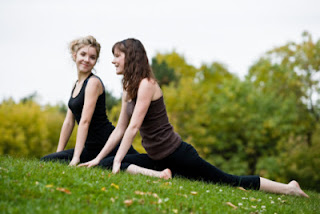
By Paul Jerard, E-RYT 500
Are you ready to make a life changing resolution? What is a daily Yoga plan? How can a daily Yoga plan reduce stress and change your life?
You can make a change at any time of the year, but New Year’s resolutions are the most popular. Yet, we often see that New Year’s resolutions do not make it past Valentine’s Day. So, if you are ready to make a change and add Yoga to your life - let’s look at a way for you to be successful for the long-term.
Get a journal and prepare it for writing. I prefer to write things down, but you may prefer a lap top, personal digital assistant, or your computer. Either way, you should write your goals down - especially the amount of time you plan to practice Yoga in a studio, at home, or on the way to and from work.
You can practice Yoga all day long. When you consider the many aspects of Hatha Yoga, you can easily incorporate them into your life. Here are some examples, but remember to incorporate these habits gradually. Do not make Yoga into a task, but take the time to enjoy the aspects, which help you deal with stress and add quality to your daily life.
In the morning, upon waking, you can practice Pranayama in bed. There are many Pranayama techniques to choose from, but you may find Dirgha breath or natural breath to be easier at this time of the day. You could practice meditation upon rising, for ten to twenty minutes, if you have the time.
Once you are up and about, you could practice asana warm-ups or Sun Salutations (Surya Namaskar). If you do not have time, you could be mindful of what you eat by eating in moderation and making wise choices.
You can work on your posture as you sit, stand, walk or perform any physical task. Is your back straight when you eat? Do you take the time to enjoy your food? Are you breathing correctly or are you already short of breath? Does coffee make you short of breath? Which foods cause you adverse reactions?
This self-observation is just another exercise in mindfulness, but will cause you to open a form of consciousness, which will improve your daily life.
In order for us to make changes, we must first want, plan, observe, take action, and practice each day. Yoga is not a physical exercise to be counted by the minutes you practice on a Yoga mat. Physical exercise is just one aspect of Hatha Yoga.
To bring your life in balance, you must identify what you do that causes your stress. This will not eliminate all of your stress, but it will identify stressful situations, which you can prevent.
This is just one example of Yogic methods applied toward better health and a less stressful life. Writing down your Yoga plan is just the start of a good habit for positive change.
© Copyright - Paul Jerard / Aura Publications
--------------------------------------------
FREE CONTENT: If you are a Yoga Teacher, Yoga studio, blogger, e-zine, or website publisher, and are in need of quality content, please feel free to use my blog entries (articles) – Please be sure to reprint each article, as is, including the resource box above. Namaste, Paul
--------------------------------------------
















